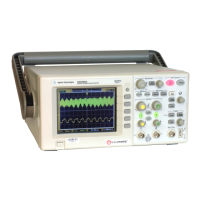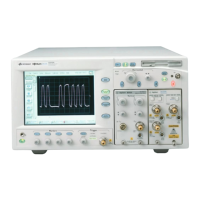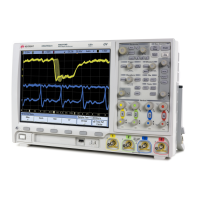CAN/LIN Triggering and Serial Decode 23
Agilent InfiniiVision 3000 X-Series Oscilloscopes User's Guide 359
Searching for CAN Data in the Lister
The oscilloscope's search capability lets you search for (and mark) certain
types of CAN data in the Lister. You can use the [Navigate] key and
controls to navigate through the marked rows.
1 With CAN selected as the serial decode mode, press [Search].
2 In the Search Menu, press the Search softkey; then, turn the Entry knob
to select the serial slot (Serial 1 or Serial 2) on which the CAN signal
is being decoded.
3 Press Search; then, select from these options:
• Remote Frame ID (RTR) — Finds remote frames with the specified ID.
Press the Bits softkey to enter the ID.
• Data Frame ID (~RTR) — Finds data frames matching the specified ID.
Press the Bits softkey to enter the ID.
• Remote or Data Frame ID — Finds remote or data frames matching the
specified ID. Press the Bits softkey to select the ID.
• Data Frame ID and Data — Finds data frames matching the specified ID
and data. Press the Bits softkey to set the ID length, ID value,
number of data bytes, and data value.
• Error Frame — Finds CAN active error frames.
• All Errors — Finds any form error or active error.
• Overload Frame — Finds CAN overload frames.
For more information on searching data, see "Searching Lister Data" on
page 128.
For more information on using the [Navigate] key and controls, see
"Navigating the Time Base" on page 60.
Setup for LIN Signals
LIN (Local Interconnect Network) signal setup consists of connecting the
oscilloscope to a serial LIN signal, specifying the signal source, threshold
voltage level, baud rate, sample point, and other LIN signal parameters.
To set up the oscilloscope to capture LIN signals:
1 Press [Label] to turn on labels.

